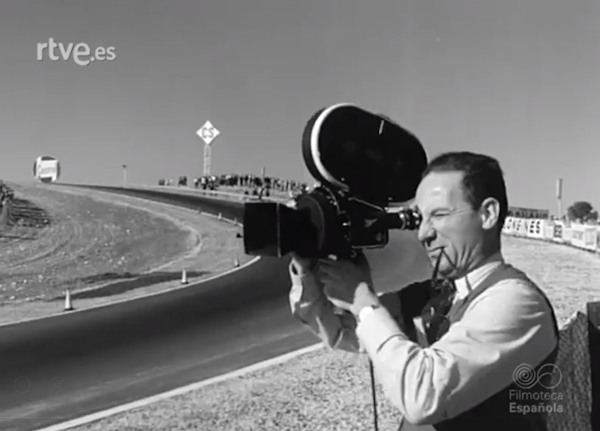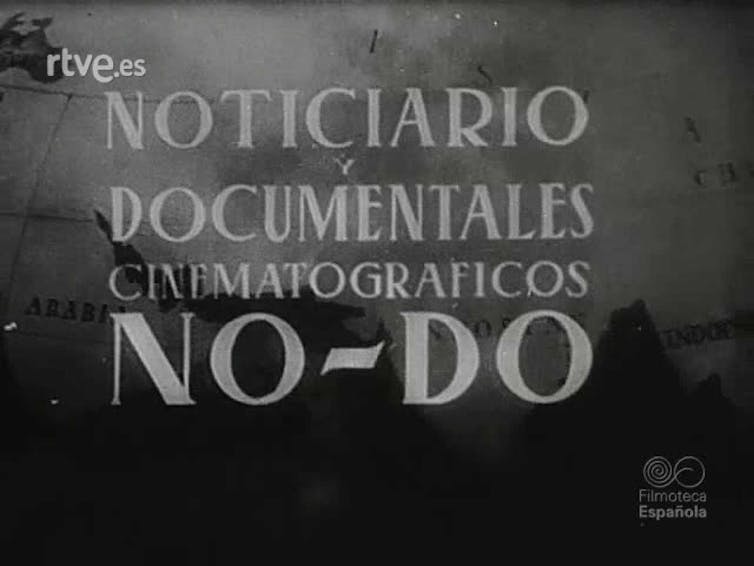Francoist propaganda centred on an obligatory screening of a 10-minute newsreel before every film, called NO-DO.
Jaume Claret is a history professor at the Open University of Catalonia. Ricard Rosich Argelich is a history professor at the University of Barcelona.
Cross-posted from The Conversation

The first ever film was shown at the Grand Café in Paris, on 28 December 1895. Interest in film and cinematic technology then quickly spread, captivating audiences and dominating much of 20th century culture. Spain’s first cinematic screenings took place in 1896, but from the 1930s onwards its cinematic output took on two significant peculiarities.
One of these was the unavoidable and entrenched practice of dubbing foreign films. This meant, in the long term, fewer opportunities for Spanish people to become familiar with other cultures and languages, and made it very easy to manipulate and censor a film’s content.
Another element, present throughout Francisco Franco’s dictatorial rule from 1939 to 1975, was the obligatory screening of a 10-minute cinematic newsreel before films. This was called the Noticiario Español (“Spanish News Broadcast”), but was more popularly known as the NO-DO, an abbreviated form of the state-owned “Noticias y Documentales” (News and Documentaries) company that created it.

Features and impact of the NO-DO
The dictatorship wanted to take advantage of a medium that sidestepped the limitations of illiteracy: around 25% of Spain’s population could neither read nor write in 1930. They also had a captive audience: from 1943 onwards, the dictatorship ordered that in all cinemas, before any film, the NO-DO had to be shown.
It also benefited from a total lack of competition, as well as the technological, suggestive power of cinema. As a result, it was able to impose its singular, one-sided worldview upon a large part of the Spanish population.
These messages formed part of a wider media ecosystem that fell under the direct or indirect control of the regime: Franco’s political party – the Falange – and the Catholic Church both held sway. This control extended to both ownership and content.
NO-DO and the dictatorship
The NO-DO’s format was simple: black and white footage with a male voiceover. It was only in the transition to democracy following Franco’s death in 1975 that it started to reflect wider technological and social changes: its first colour instalment was broadcast in June 1977, and the first female voiceover did not come until December 1979.
Outside of this final period, the NO-DO’s content toed the Francoist party line with surgical precision.
It only addressed topics that were entertaining, politically convenient, and could be shown in a light-hearted way, without any obvious ideological spin. Its central mission, however, was to legitimise Franco’s cause or, at least, to sugarcoat events both within Spain and in the world at large.
This heavy bias is evident in how it handled topics such as representation of women, Spain’s various regional identities(often reduced to tame folkloric dance performances for visiting dignitaries) or the proganda offensive celebrating the Franco regime’s so-called 25 Years of Peace.
Some were critical of, or perhaps even immune to, the propaganda, but it was an effective way to spread biased information, and to shape society’s thinking by indoctrinating or persuading a captive audience. Similar broadcasts were used by Spain’s totalitarian contemporaries, including fascist Italy, Nazi Germany, and Soviet Russia.
News in the cinema
Before and during the Spanish Civil War, there is actually evidence of each side having its own cinematic newsreels. There are examples of a Noticiario Español and another broadcast called Espanya al dia (Catalan for “Spain Up To Date”) in the eastern republican part of the country. The western rebel territory had its own newsreel – also called Noticiario Español – in 1938 and 1939.
The NO-DO came about after the Civil War thanks directly to the Francoist dictatorship’s power, which made it the sole production of this sort. First screened on 4 January 1943, it actually continued into the post-Franco era, ending on 25 May 1981.
However, its glory began to fade as early as the 1960s, when competition emerged in the form of television (Spain’s public broadcaster, TVE, was inaugurated in 1956). It entered an even steeper decline in the late 1970s when it stopped being mandatory in cinemas, by which point television had spread more widely into households, holding sway over people’s conversations, timetables, and even the layout of their homes.
The legacy of the NO-DO
The NO-DO ended well within living memory, and left a profound impression on the country’s collective consciousness.
To this day, numerous elements still resonate with much of Spain’s popular culture. Few can forget its iconic opening melody, the pompous voiceovers, and the hackneyed speeches filled with platitudes like “su excelencia el Jefe del Estado” (“His Excellency, the Head of State”). Its repeated references to newly inaugurated marshes, reservoirs and wetlands even led to the dictator being popularly known as “Paco el Rana” (“Frankie the Frog”).
It also left its mark on those who were not alive to see it first hand. One clear example of this is the long-running Catalan political satire programme Polònia, which riffs on the NO-DO’s format and has aired weekly since 2003.
It also has considerable value as a historical archive. Its extensive output – a total of 4,106 episodes – has been digitised in its entirety by RTVE and the Filmoteca Española. It provides a wealth of material for researchers interested not only in Francoism, but also in the country’s tumultuous transition to democracy.
All of these topics, and more, have been addressed in the recent monograph “80º Aniversario del noticiario del NO-DO (1943-2023)” (“The 80th Anniversary of the NO-DO Newsreel (1943-2023)”) published by the scientific journal FILMHISTORIA Online.
The NO-DO has to be viewed with a critical eye, since it is as biased and effective as it is fascinating. However, when handled carefully it provides a powerful tool to help us understand, study and scrutinise our country’s recent past.
Thanks to many generous donors BRAVE NEW EUROPE will be able to continue its work for the rest of 2024 in a reduced form. What we need is a long term solution. So please consider making a monthly recurring donation. It need not be a vast amount as it accumulates in the course of the year. To donate please go HERE.


Be the first to comment